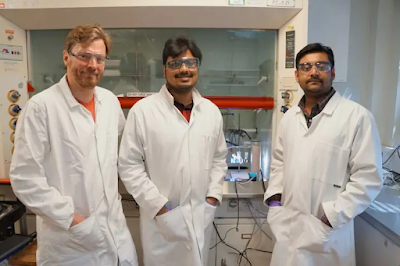|
About Topic In Short: |
|
|
|
Who: University
of Cambridge, Authors - Sayan Kar, Motiar Rahaman, Virgil Andrei, Subhajit
Bhattacharjee, Souvik Roy, and Erwin Reisner. |
|
What: The
researchers from the University of Cambridge developed a solar-powered
reactor that converts captured CO2 and plastic waste into sustainable fuels
and valuable chemical products. |
|
|
How: The
solar-powered reactor captures CO2 from real-world sources, such as
industrial exhaust or the air itself, and combines it with plastic waste. Air
is bubbled through the system containing an alkaline solution, trapping CO2
while allowing other gases to escape. The plastic waste donates electrons to
CO2, converting it into glycolic acid, while CO2 is transformed into syngas,
a fundamental building block for sustainable fuels. |
|
The
esteemed University of Cambridge has reached a groundbreaking milestone in
sustainable energy research with the ingenious creation of a solar-powered
reactor, empowered to convert CO2 emissions from industrial processes, air, and
plastic waste into valuable and sustainable fuels and chemicals. This
revolutionary breakthrough carries the potential to revolutionize our approach
to combatting climate change and steer us towards a circular economy,
liberating us from the shackles of fossil fuels.
Background
and Research Endeavors:
Under the
guidance of the illustrious Professor Erwin Reisner, the research group from
the eminent Yusuf Hamied Department of Chemistry has been trailblazing the path
of sustainable, net-zero carbon fuels, drawing inspiration from
photosynthesis—a process akin to how plants harness sunlight to create
sustenance. With artificial leaves, they emulate nature's magic, transforming
CO2 and water into precious fuels through the power of solar energy.
Initially,
their solar-driven experiments centered around concentrated CO2 extracted from
a cylinder. Yet, as visionary pioneers, they discerned the imperative to
actively capture CO2 from the real world, be it industrial emissions or the
very atmosphere, to bring practicality to their technological marvel. This
impelled the development of an integrated system, astutely designed to
selectively ensnare and concentrate CO2 from the ambient air, courtesy of an
alkaline solution, magnifying the potential of their innovation for industrial
application.
The
Remarkable Journey:
The
solar-powered reactor embarks on its task by orchestrating a delightful ballet
of air bubbles through the labyrinth of an alkaline solution, deftly ensnaring
CO2 while granting clemency to its companions, nitrogen, and oxygen. A
symbiotic partnership with plastic waste lends its generous electrons to CO2,
metamorphosing into glycolic acid—a cherished asset to the cosmetics industry.
Simultaneously, CO2 undergoes a transformation into syngas, the very
cornerstone of sustainable liquid fuels.
Real-World
Ramifications:
The
ability to tap into CO2 from our concrete reality constitutes a momentous
stride towards taming carbon emissions. Empowered by the solar-driven
technology, captured CO2 metamorphoses into a veritable cornucopia of
invaluable fuels and chemicals, all under the benevolent gaze of sunlight. An
emancipation from environmentally perilous oil and gas extraction methods
beckons, ushering us towards a cleaner and greener destiny.
The
Vistas of the Technology:
To be
sure, the journey towards industrial-scale application calls for further
strides. Yet, the resplendent findings published in the prestigious journal
Joule herald a glorious chapter in the saga of pristine, renewable fuels. With
unyielding spirit, the diligent team presently toils on a bench-top
demonstrator, its very existence a testament to the virtues of direct air
capture coupled with CO2 utilization, a harbinger of a radiant, carbon-neutral
epoch.
Thus,
Echo the Virtuosos:
Professor
Erwin Reisner's resounding clarion call envisions not only decarbonization but
de-fossilization, relegating fossil fuels to oblivion and ushering in an era of
capturing CO2 straight from the arms of the heavens. He also extols the
virtuous potential of converting harnessed CO2 into fuels, liberating it from
the depths of the earth's bosom.
Co-first
author Dr. Sayan Kar passionately accentuates the monumental significance of
the solar-powered system, its wondrous alchemy transforming noxious waste like
plastic and carbon emissions into veritable treasures, harmoniously aligning
with the philosophy of a circular economy.
Co-first
author Dr. Motiar Rahaman pays fervent tribute to the plastic component, a
profound catalyst that facilitates CO2's metamorphosis from the air into a
panoply of fuels, elevating the process's efficacy to celestial heights.
In
Conclusion:
The birth
of the solar-powered reactor from the venerable University of Cambridge marks a
veritable epoch in sustainable energy research. Empowered to capture CO2 from
the veritable crucible of our world and transmute it into precious fuels
through the radiant grace of solar energy, this transformative technology
steers humanity towards a fossil-fuel-free utopia. As industrial applications
beckon with bated breath, the research's alluring promise in forging a cleaner,
greener destiny gleams ever brighter.
Image
Gallery
|
|
University of Cambridge researchers have developed a solar-powered reactor that turns CO2 from industrial emissions or air and plastic waste into sustainable fuels and valuable chemicals. The breakthrough research highlights a critical stride towards a fossil-fuel-free, circular economy. (Artist’s concept.) |
|
Photograph showing carbon capture from air and its photoelectrochemical conversion into fuel with simultaneous waste plastic conversion into chemicals. Credit: Ariffin Mohamad Annuar |
|
L-R: Erwin Reisner, Sayan Kar, Motiar Rahaman. Credit: Ariffin Mohamad Annuar |
|
All Images Credit: from References/Resources
sites [Internet] |
Hashtag/Keyword/Labels:
#SolarPoweredReactor
#CO2Conversion #SustainableFuels #CircularEconomy #CleanEnergy
#UniversityOfCambridge
References/Resources:
1.
https://www.azocleantech.com/news.aspx?newsID=32797
4.
https://www.inceptivemind.com/solar-powered-reactor-converts-plastic-co2-sustainable-fuels/
For more such blog posts visit Index page or click InnovationBuzz label.
…till next
post, bye-bye and take-care.





No comments:
Post a Comment